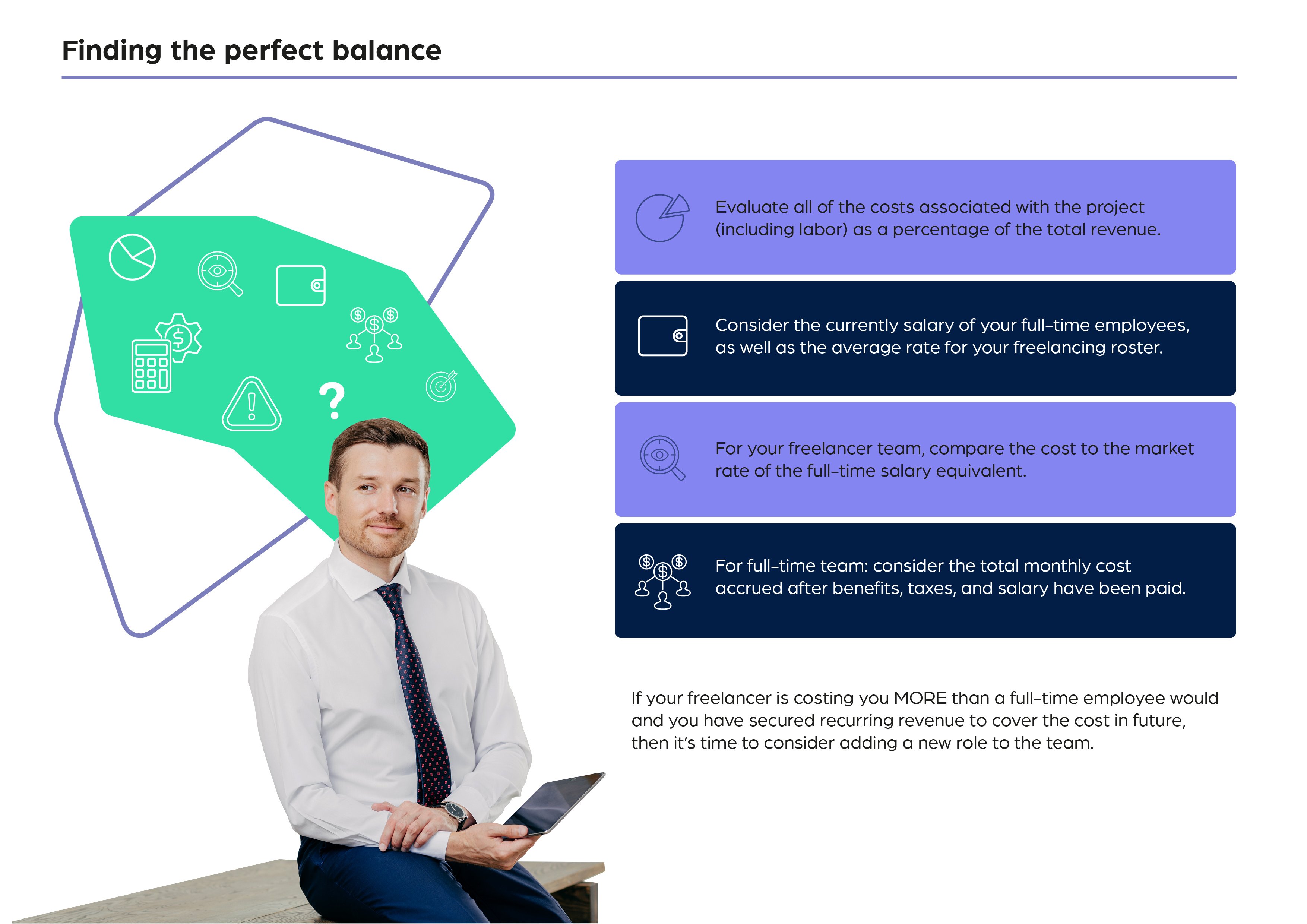
Picture this:
Your most favorable client comes to you at the last minute, requesting a deliverable on a REALLY tight deadline.
Even though your full-time team is stacked with other work, you can’t afford to miss out on the extra revenue boost. Luckily, you have a roster of reliable freelancers to reach out to.
You delegate the project, pay the freelancer’s one-time invoice, and the client leaves happy.
Leveraging a (good) freelancer can be an amazing asset to meeting tight deadlines and specialized deliverable demands, especially with a younger agency. When monthly revenue isn’t as predictable, using freelancers lift the pressure of upholding monthly salaries and benefits.
While the lack of commitment and overhead costs may seem like best option in the moment, over-saturating your team with your freelance team may be hurting your business in the long run.
If you’re struggling to:
- Find the most cost effective between freelance and full-time employees
- Gain enough momentum to start hiring a full-time team
- Need help deciding when to hire a freelancer or not
Then read on to discover the solution to the problem that will cost you big time in the long run.
Here for a good time, not a long time
Freelancers can be great for handling overflow work or filling specific skills gaps on a short-term basis. Plus, they're usually more flexible and available on an as-needed basis. Freelancers can be incredibly beneficial for your business in the earlier stages, as you are taking on newer projects and are still discovering the needs of clients within your niche. There are however, some risks to consider.
One risk is that freelancers may not be as invested in the success of your agency as a full-time employee. They may not have the same level of commitment to your company's values and goals, or be as interested in building a long-term relationship with your agency. This can make it harder to get them to fully buy into your processes and standards, making it more difficult to ensure that they are delivering work that meets your expectations. You’ll need crystal clear communication in place to get them up to speed and ensure that they are meeting deadlines and delivering high-quality work.
Finally, there is also a risk that you may have difficulty scaling up or down as your workload changes if you rely heavily on freelancers. It can be harder to add more freelancers to your team on short notice, and it can be more challenging to let them go if you no longer need their services.

Is full-time better?
There’s a reason businesses across the board agree that hiring a full-time team is essential to successfully scale. They are typically more dedicated and committed to the success of your company, therefore they can be more easily integrated into your team and processes. They generally have better availability compared to freelancers, which can make it easier to coordinate and ensure that projects are moving forward in a timely manner.
In some cases, hiring full-time employees can actually be more cost-effective than relying on freelancers, particularly when you consider the benefits and other costs associated with full-time employment. However, it's important to be mindful of the risks of hiring too many full-time team members too soon.
Remember that full-time employees strain your budget and resources. They come with additional costs beyond just their salary, such as benefits and potentially higher overhead expenses. Paying these salaries is a non-negotiable cost, which can be especially problematic if you're not seeing a corresponding increase in revenue to offset the expense.
Having a full-time team often feels like a balancing act - ensuring no one is too busy or too bored. Employees become frustrated if they feel like they have an unbalanced workload, which can lead to low morale and high turnover. You’ll be having some difficult conversations if you've hire more people than you really need.
Finding the perfect balance

Imagine that your agency has just signed a new client, and you need to bring on additional help to accommodate the workload.
When determining the perfect blend of freelancers and full-time team for your agency, let the numbers make the decision for you.
- Evaluate all of the costs associated with the project (including labor) as a percentage of the total revenue.
- Consider the currently salary of your full-time employees, as well as the average rate for your freelancing roster.
- For your freelancer team, compare the cost to the market rate of the full-time salary equivalent.
- For full-time team: consider the total monthly cost accrued after benefits, taxes, and salary have been paid.
If your freelancer is costing you MORE than a full-time employee would and you have secured recurring revenue to cover the cost in future, then it’s time to consider adding a new role to the team.
If you’re still unsure about what future revenue or workload looks like, and/or your freelancer is still cheaper than paying a full-time employee, don’t jump at making the transition just yet.
Remember that growth is a marathon not a sprint. By carefully evaluating your labor costs as a percentage of revenue and considering the potential risks and benefits of each option, you can make an informed decision about whether to hire freelancers or full-time employees.
